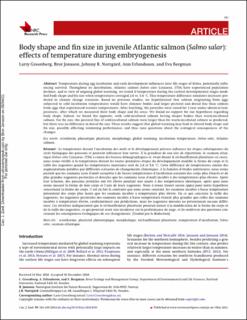Body shape and fin size in juvenile Atlantic salmon (Salmo salar): effects of temperature during embryogenesis
Peer reviewed, Journal article
Published version

View/
Date
2021Metadata
Show full item recordCollections
- Publikasjoner fra CRIStin - NINA [2364]
- Scientific publications [1392]
Abstract
Temperature during egg incubation and early development influences later life stages of fishes, potentially influencing survival. Throughout its distribution, Atlantic salmon (Salmo salar Linnaeus, 1758) have experienced population declines, and in view of ongoing global warming, we tested if temperature during the earliest developmental stages modified body shape and fin size when temperatures averaged 2.6 vs. 5.6 °C. This temperature difference simulates increases predicted in climate change scenarios. Based on previous studies, we hypothesized that salmon originating from eggs subjected to cold incubation temperatures would have slimmer bodies and larger pectoral and dorsal fins than salmon from eggs that experienced warmer temperatures. After hatching, the juveniles were raised for 1 year under identical temperatures, after which we measured their body shape and fin areas. We found no support for our hypothesis regarding body shape. Indeed, we found the opposite, with cold-incubated salmon having deeper bodies than warm-incubated salmon. For fin size, the pectoral fins of cold-incubated salmon were larger than for warm-incubated salmon as predicted, but there was no difference in dorsal fin size. These results suggest that global warming may lead to altered body shape and fin size, possibly affecting swimming performance, and thus raise questions about the ecological consequences of the changes. ectotherm, phenotypic plasticity, morphology, global warming, incubation temperature, Salmo salar, Atlantic salmon.